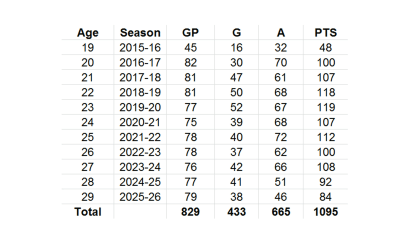McDavid has 148 points (46 goals, 102 assists) in those 127 games, an average of 1.17 points per game. Once the adjustment for era is made, two players have scored at least 1.17 adjusted points per game through their age-20 season since the 1967-68 expansion: Wayne Gretzky of the Oilers, with 1.35; and Sidney Crosby of the Pittsburgh Penguins, with 1.28.
Because a projection based on two players is statistically tenuous, the four other players who are above 1.0 adjusted points per 60 minutes will be added: Alex Ovechkin, 1.16; Mario Lemieux, 1.11; Eric Lindros, 1.10; and Evgeni Malkin, 1.01. Using six players creates a group with an average of 1.17 adjusted points per 60 minutes, just like McDavid.
At first glance, it might seem premature to base McDavid's projection on those players, but his scoring rate has been that exceptional. At even strength, McDavid has averaged 2.82 points per 60 minutes, according to Hockey Analysis. Over the past two seasons, no other player has scored more than McDavid and Crosby (2.60; minimum 500 minutes played).
RELATED: [Onus on Oilers to make McDavid's contract worth it | Oilers shift focus to Draisaitl]
Basing McDavid's projection on the average era-adjusted performance of those six players in their age 21 through age 29 seasons, McDavid would have 992 points in 751 games by the time the contract expires in 2026. That result assumes McDavid would miss 114 games over the next nine seasons, about 13 per season.
Missing 114 games makes sense when you consider that four of the six players sustained at least one serious injury in his 20s. Up until age 29, Malkin missed 142 games, Lindros missed 151, Crosby missed 168, and Lemieux missed 209. Ovechkin and Gretzky missed 26 and 33 games, respectively.
Given that four of the six highest-scoring forwards in recent history missed significant time with injury, it is possible the same thing will happen to McDavid. He already missed 37 games with a fractured collarbone in 2015-16.
For purposes of this projection, let's assume better luck for McDavid. If it is recalculated under the arbitrary assumption that Malkin, Lindros, Crosby and Lemieux missed one-quarter as many games as they did, then McDavid could miss as few as 36 games and would accumulate 1,095 points in 829 games by age 29.



















